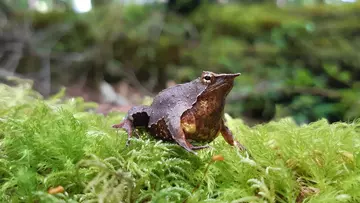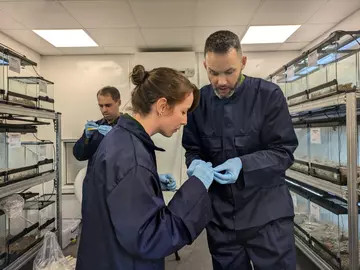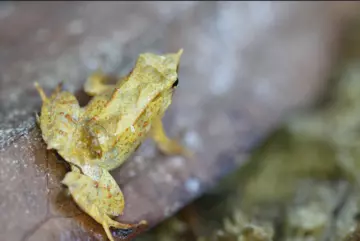
Hidden deep in the rainforests of southern Chile, a tiny amphibian with an extraordinary survival strategy is fighting for its future. The Darwin’s frog (Rhinoderma darwinii) is one of the few species in the world where males care for their young inside their vocal sacs, protecting them until they emerge as fully formed froglets.
But today, these frogs face an urgent crisis. Their populations are plummeting due to chytrid fungus, a devastating amphibian disease, and widespread habitat destruction. Without intervention, Darwin’s frogs could disappear forever.
Watch the Full Documentary: The Fight to Save an Endangered Species
Follow a team of ZSL scientists as they embark on a high-stakes rescue mission to protect Darwin’s frogs before it’s too late. From the misty forests of Tantauco Park in Chile to the bio-secure enclosures at London Zoo, this documentary captures their journey to save one of the world’s most unusual amphibians.
The team successfully relocated 53 Darwin’s frogs, leading to an incredible breakthrough—33 new froglets have since been born at London Zoo. This marks a vital step toward securing the species’ future.
We couldn't have achieved this amazing success without the support of Parque Tantauco, Ranita de Darwin, Universidad Andrés Bello, Universidad de Concepción, and Zoo Leipzig.
Why are Darwin’s frogs endangered?
As part of ZSL’s mission to protect species, our research has identified two critical threats pushing Darwin’s frogs toward extinction:
- Chytrid fungus infection: This deadly amphibian disease disrupts frogs' ability to breathe through their skin, often proving fatal.
- Habitat loss: Logging, deforestation, and climate change are rapidly shrinking the temperate rainforests where these frogs live.

To combat these challenges, ZSL is working to restore habitats, support captive breeding programs, and develop long-term strategies to protect amphibians in the wild.
How ZSL is creating change for Darwin’s frogs
ZSL is committed to ensuring a future for Darwin’s frogs through our global conservation strategy, which focuses on:
- Protecting species: Establishing a safe breeding population at London Zoo to prevent extinction.
- Restoring habitats: Collaborating with partners in Chile to conserve critical frog habitats in the Valdivian rainforest.
- Training conservationists: Providing expertise and scientific training to help local researchers in Chile monitor wild populations.
- Creating change: Raising awareness about amphibian conservation and the threats posed by chytrid fungus to species worldwide.
Conservation success at London Zoo
After a 7,000-mile journey, the rescued frogs arrived at London Zoo, where they are now thriving in a specially designed bio-secure habitat. These controlled conditions protect them from disease and environmental stress while supporting a breeding program that could one day lead to reintroductions into the wild.
Since their arrival, the first generation of captive-born froglets has hatched—an essential milestone for the species' survival.

Fast facts about Darwin’s frogs
- Scientific name: Rhinoderma darwinii
- Habitat: Humid, temperate rainforests of southern Chile and Argentina
- Size: 1–3 centimeters
- Conservation status: Endangered (IUCN Red List)
- Main threats: Chytrid fungus, habitat destruction, climate change
- Unique adaptation: Males carry and protect their young inside their vocal sacs

What Makes Darwin’s Frogs Unique?
Darwin’s frogs are among the most unusual amphibians on Earth. Unlike most frogs, they have pointed snouts and camouflaged skin, helping them blend seamlessly into leaf litter. Their most remarkable feature is their parenting strategy—males protect their young inside their mouths until they are fully developed.
Unfortunately, their close relative, the northern Darwin’s frog, has not been seen since 1981 and is thought to be extinct. Protecting the southern Darwin’s frog is now more critical than ever.

Where Do Darwin’s Frogs Live?
Darwin’s frogs inhabit the temperate rainforests of Chile and Argentina, thriving in the damp, mossy undergrowth. They were once widespread but are now confined to small, fragmented populations.
ZSL is working with Chilean conservationists to restore key habitats, ensuring that future generations of Darwin’s frogs have a safe home in the wild.
How You Can Help Protect Endangered Amphibians
- Donate to ZSL: Support our work to protect species and combat the global amphibian crisis.
- Visit London Zoo: Learn about amphibian conservation and see the Darwin’s frogs in their specially designed habitat.
- Spread awareness: Share the documentary and raise awareness about the impact of chytrid fungus on amphibians worldwide.
The Future of Darwin’s Frogs
The success of the Darwin’s frog breeding program at London Zoo represents a groundbreaking step in amphibian conservation. With continued research and support, ZSL hopes to reintroduce these frogs back into protected habitats in Chile.
By supporting ZSL, you can help protect species, restore habitats, train conservationists, and create change—ensuring a future for one of the world’s most extraordinary amphibians.
